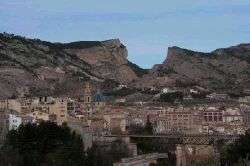Alcoy, Spain
| Alcoi/Alcoy | |||
|---|---|---|---|
| Municipality | |||
| Alcoi | |||
 | |||
| |||
 Alcoi/Alcoy Location in Spain | |||
| Coordinates: 38°41′54″N 0°28′25″W / 38.69833°N 0.47361°W | |||
| Country |
| ||
| Autonomous community |
| ||
| Province | Alicante | ||
| Comarca | Alcoià | ||
| Judicial district | Alcoi | ||
| Government | |||
| • Mayor | Antonio Francés Pérez (2011) (PSOE) | ||
| Area | |||
| • Total | 129.86 km2 (50.14 sq mi) | ||
| Elevation | 562 m (1,844 ft) | ||
| Population (2010) | |||
| • Total | 95,526 | ||
| • Density | 740/km2 (1,900/sq mi) | ||
| Demonym(s) |
Alcoià, alcoiana (Valencian) alcoyano, alcoyana (Spanish) | ||
| Time zone | CET (UTC+1) | ||
| • Summer (DST) | CEST (UTC+2) | ||
| Postal code | 03801-03804 and 03818 | ||
| Official language(s) | Valencian, Spanish | ||
| Website | Official website | ||
Alcoy (Spanish: [alˈkoi]) or Alcoi (Valencian: [aɫˈkɔj]) is an industrial and university city and municipality located in the province of Alicante, Spain. The Serpis river crosses the municipal boundary of Alcoi. The local authority reported 95.526 residents in 2010.[1][2]
History
The first traces of human presence in the area date to c. 60,000 years ago, when Neandertal hunters settled here. A site with rock paintings, dating to c. 10,000/6,500 years ago, has been discovered near la Sarga. From around the mid-3rd millennium BC people started to move from the caves to the plain where cereals were grown, while mountain fortifications were erected (Mola Alta de Serelles, Mas del Corral, Mas de Menente, El Puig).
After the Roman conquest of the Iberians, several rural villas were built in the area, as well as a necropolis. The town was established in 1256 by James I of Aragon, with the construction of a castle on a strategic position over the Serpis river, to secure the southern frontier of the Kingdom of Valencia during the Reconquista.
In 1291 the town was donated by King James II of Aragon to the Sicilian admiral Roger of Lauria; it will not return a royal possession until 1430.
During the War of Spanish Succession, Alcoi sided for the cause of archduke Charles, and was therefore besieged and stripped of numerous privileges, which started a period of decline.
In 1873 the workers of Alcoy revolted in the Petroleum Revolution.
Main sights
Many outdoor rock paintings exist in Alcoi, and there are some ruins of an Iberian settlement with fragments of Greco-Roman pottery.
Buildings with artistic or historical interest in the city include:
- Barchell Castle (13th century), of likely Muslim origin. It has a rectangular keep and a court with a rainwater tank.
- hermitage of St. Anthony the Abbot (14th-18th centuries)
- the Archeological Museum
- the convent of Sant Agustí, reconstructed in the 18th century with paintings of the 16th century
- Catholic church of Santa Maria, in Valencian Baroque style
- Torre de Na Valora, a watchtower from the 13th century
Economy
Alcoi had an important industry related to textile, paper, food and metal. Furthermore, it had many factories which manufacture matches. Today, Alcoi is the financial, commercial and cultural center in the surrounding area.
Culture
Alcoy hosts the oldest Cavalcade of Magi in the world. The Jesuset del Miracle is commemorated on the last day of January. The most important touristic celebration is Moros i Cristians, in April.
Sport
The local football club CD Alcoyano is famous across Spain for a proverbial match in which they were facing a very adverse score. When the referee was about to close, the Alcoyano players kept asking for more time to score back and reach a draw.[3]
Thus the phrase tener más moral que el Alcoyano ("to have a greater morale than Alcoyano") ponders an undefatigable person. Currently they play in the Segunda División B.
The city is also home to PAS Alcoy, a Spanish roller hockey club, which plays in the OK Liga,the first division of roller hockey in Spain.
See also
References
- ↑ "Estadísticas de la población". Ajuntament d'Alcoi (in Spanish). Archived from the original on 7 October 2010. Retrieved 17 October 2010.
- ↑ "Estadísticas de la población - Por paises de procedencia". Ajuntamient d'Alcoi (in Spanish). Archived from the original on 24 July 2011. Retrieved 17 October 2010.
- ↑ Notas de fútbol: Tienes más moral que el Alcoyano
External links
| Wikivoyage has a travel guide for Alcoy. |
| Wikimedia Commons has media related to Alcoy. |
- Alcoi Foto Pictures of Alcoi and Moros i Cristianos festivity in Alcoi.
- Christians & Moors Festival Images and a video.
- Alcoi Text, Images and Video.

